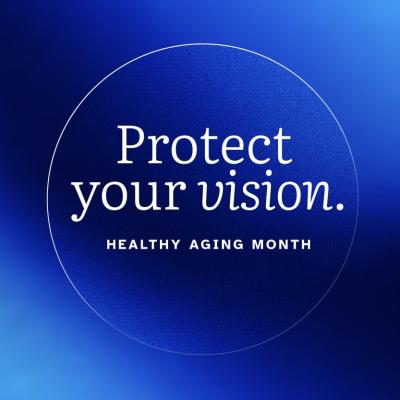
September is Healthy Aging Month
Getting older doesn’t have to mean losing your vision. While some vision changes are a normal part of getting older, vision loss related to eye diseases and conditions can be prevented. Learn how healthy eye habits, like getting a regular dilated eye exam and eating a diet rich in dark leafy greens, can help keep your sight strong for years to come.
Help the National Eye Health Education Program (NEHEP) encourage healthy eye habits for Healthy Aging Month! Download resources, get tips, and spread the word.
Share these resources
Use our resources to spread the word about healthy aging and vision.
-

-

-

See our publication library
Order print materials by emailing 2020@nei.nih.gov or calling 800-680-2578.

Help people talk with their doctor about AMD
AMD is complicated, and it’s normal for people to be overwhelmed — especially when they’re dealing with a new diagnosis. This guide makes it easy for people recently diagnosed with AMD to talk to their doctor about the condition. It includes:
- Information about AMD
- Questions for the doctor
- A symptom tracker

Give a presentation
You can share important information about how people can protect their eyes as they age.
Spread the word on social media
Use the sample posts below to tell your followers about Healthy Aging Month. Remember to tag us on X (@NatEyeInstitute) and Facebook (@NationalEyeInstitute), and LinkedIn (@National-Eye-Institute-NEI).
X
Your risk for certain eye diseases and conditions increases as you age, but early detection can lead to the best possible outcomes. Talk to your eye care professional about regular dilated eye exams and learn how healthy eye habits can help reduce your risk: nei.nih.gov/healthyaging
Getting older doesn’t have to mean giving up your vision. After the age of 60, getting a dilated eye exam every 1 to 2 years is one of the most important steps you can take to safeguard your sight. Learn more healthy eye habits for #HealthyAgingMonth: nei.nih.gov/healthyaging
#HealthyAgingMonth is the perfect time to start taking steps to protect your sight. While vision changes as we age, vision loss doesn’t have to be part of getting older. Follow along as we share steps we can all take to safeguard our sight. See more here: nei.nih.gov/healthyaging
Are you a caregiver, educator, or community leader? Explore the @NatEyeInstitute #HealthyAgingMonth resources to promote vision health in #OlderAdults: https://nei.nih.gov/learn-about-eye-health/resources-for-health-educators/vision-and-aging-resources/healthy-aging-month #HealthyVision
Help older adults in your community protect their vision! Use the @NatEyeInstitute See Well for a Lifetime toolkit this #HealthyAgingMonth to lead engaging #CommunityHealth sessions: https://nei.nih.gov/learn-about-eye-health/resources-for-health-educators/vision-and-aging-resources/see-well-lifetime-toolkit
Your risk for certain eye diseases and conditions increases as you age. These include age-related macular degeneration, cataracts, diabetic retinopathy, and glaucoma. Like many diseases or conditions, early detection can lead to the best possible outcomes. Talk to your eye care professional about regular dilated eye exams and learn how healthy eye habits can help reduce your risk: nei.nih.gov/healthyaging #HealthyAgingMonth
Getting older doesn’t have to mean giving up your vision. After the age of 60, getting a dilated eye exam every 1 to 2 years is one of the most important steps you can take to safeguard your sight. Learn more healthy eye habits for #HealthyAgingMonth: nei.nih.gov/healthyaging
Age-related Macular Degeneration (AMD) is a leading cause of vision loss for older adults. AMD leads to loss of central vision that can make everyday activities more difficult. A dilated eye exam can help you catch AMD early. Fortunately, there are steps you can take to lower your risk. Learn how for #HealthyAgingMonth: nei.nih.gov/healthyaging
Vision changes don’t have to impact your quality of life. Common changes, like trouble focusing on an object or needing more light to see well, can be corrected with glasses or improved lighting. Learn what to expect from your eyes as you age, and how to keep them seeing well, for #HealthyAgingMonth: nei.nih.gov/healthyaging
Protect your vision and reduce your risk for eye disease with these healthy eye habits. Which ones will you try for #HealthyAgingMonth?
- ?️ Get an annual eye exam
- ? Eat a diet rich in green leafy vegetables and fis
- ? Stay active and quit smoking
- ? Wear sunglasses and protective eyewear
The risk for certain eye diseases and conditions increases with age. These include age-related macular degeneration, cataracts, diabetic retinopathy, and glaucoma. Like many diseases or conditions, early detection can lead to the best possible outcomes. Learn how regular dilated eye exams and healthy eye habits can help reduce risk: nei.nih.gov/healthyaging #HealthyAgingMonth
Vision changes don’t have to impact quality of life. Common changes, like trouble focusing on an object or needing more light to see well, can be corrected with glasses or improved lighting. Learn about vision changes that come with age, for #HealthyAgingMonth: nei.nih.gov/healthyaging
Age-related Macular Degeneration (AMD) is a leading cause of vision loss for older adults. AMD leads to loss of central vision that can make everyday activities more difficult. A dilated eye exam can help catch AMD early. Learn more for #HealthyAgingMonth: nei.nih.gov/healthyaging
Supporting older adults means supporting their vision health. Whether you’re a healthcare provider, public health leader, or caregiver, NEI offers helpful tools for your community this #HealthyAgingMonth: nei.nih.gov/healthyaging
Leading a wellness program for older adults this fall? NEI’s See Well for a Lifetime toolkit provides presentations, handouts, and outreach materials to help educate your audience on preventing vision loss: https://nei.nih.gov/learn-about-eye-health/resources-for-health-educators/vision-and-aging-resources/see-well-lifetime-toolkit #HealthyAgingMonth #OlderAdults